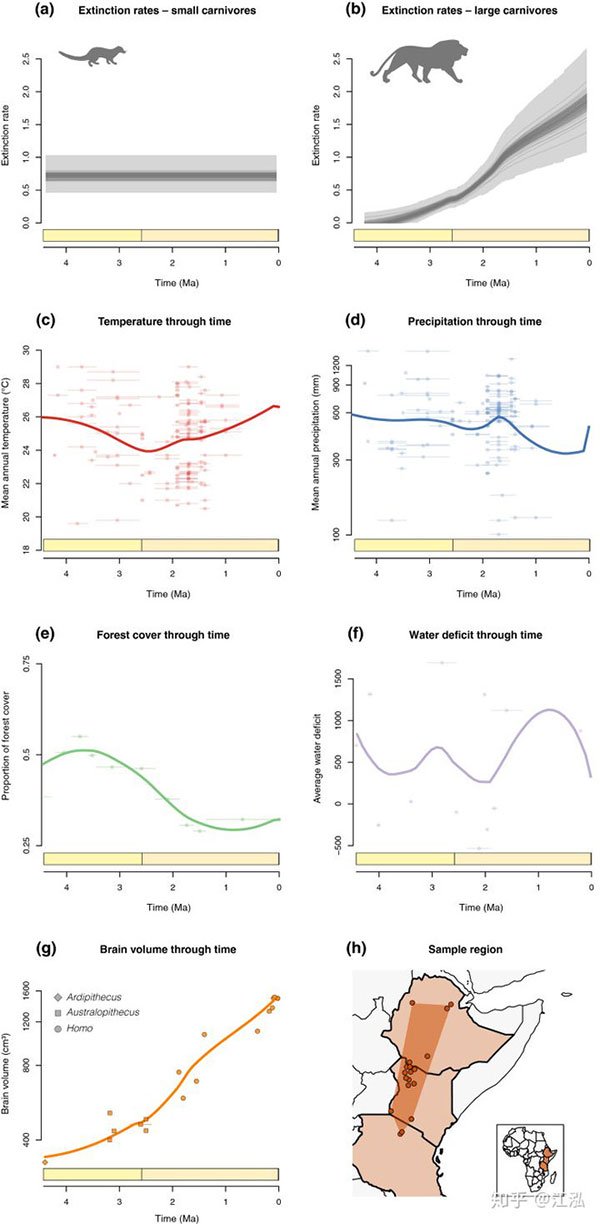Human ancestors caused the extinction of animals 4 million years ago
Modern human activities have caused enormous damage to the Earth, ecological environment, and many animals have become extinct because of this, some typical species can be mentioned such as Tasmanian wolf , passenger pigeon, chin Dodo, Chinese spoon sturgeon .
We have even caused the extinction of animals since the ice age tens of thousands of years ago, but a new study published in the journal Ecology Express suggests that our ancient ancestors had caused the extinction of animals from 4 million years ago.
The paper, titled "Brain expansion in early hominins predicts carnivore extinctions in East Africa" - "Brain expansion in early apes predicted the extinction of predators in East Africa" , was published by a International scientific group from UK, Switzerland and Sweden.
The comparison of data proves that the crisis of human biodiversity today is not a new phenomenon and our distant ancestors began to accelerate this process millions of years ago. .

We have caused much damage to nature.

Data analysis chart in the research paper.
Before the end of the extinction of the human-induced Pleistocene, paleontologists often assumed that the extinction of animals was due to climate change. But when looking at climate change in Africa, the researchers found that in millions of years, climate change in Africa was much smaller than other continents, but the species extinction still appear. It seems that climate is not the main cause of animal extinction in Africa.
When the scientists turned their research to East Africa, they found that most ancient East African predators were almost extinct and most likely their extinction. involve fierce competition with our ancestors in the battle for the top of the food chain.
East Africa has long been known as the center of the evolution of human ancestors. Early humans from Orrorin tugenensis to Ardipithecus (ground ape), Australopithecus (southern genus), our ancestors moved their habitat from the jungle to the meadow, then stood upright and moved on their feet following and reaching the shape almost the same as we are today.
Paleontologists have discovered that East Africa has experienced many extinctions since the earliest days of the distant human ancestor (5 to 4 million years ago).
After collating and analyzing fossils, paleontologists have even found that during this period, the number of large predators has decreased significantly. The starting point for this decline process was 4 million years ago.

Ardipithecus (gibbon land).

Australopithecus (southern hominid).
Paleontologists believe that the decline in large numbers of predators in East Africa is due to the "Klepoparasitism" - the dominant species that can rob food from subordinate species.
This phenomenon can be easily seen in the wild natural environment today as the lion or hyena will go to steal the spoils of cheetahs, seals will catch small fish caught by terns. .

A cheetah has just killed an Impala antelope and eaten a portion of its prey, creating a target for parasite to steal.Three minutes later: one spotted hyena then the other run towards the cheetah that is feeding.38 seconds later: The cheetah fled without resistance, the vulture would also join the robbery parasite: when the hyena moved a piece of carcass, the vulture would take the leftover piece from the ground.

Eagles steal food from gulls.
In prehistoric East Africa, human ancestors (Southern apes, etc.) were able to steal food from other carnivores right after they had just finished their prey. This causes predators to starve to death as they do not have enough food. Over time, the number of human ancestors increased and the robbery took place more and more, which led to the decline or even extinction of all predator species.

Over time, the number of human ancestors increased and the act of robbery took place more and more often.
In fact, this research has surprised everyone by our far-fetched creatures who are very weak creatures and can easily become prey for Dinofelis - an excellent saber-toothed cat. strains. But in fact, this study has shown that our ancestors relied on the number of factors as well as the flexible hands that can wield a tool to force predators to abandon their loot. .

Human ancestors were easy prey for large mammals alone.


Cheetahs will pull their prey up the tree to eat after a successful hunt.

Predators such as lions and hyenas protect their prey together in groups.
Because of the pressure of their prey that can be stolen or robbed, most large predators in Africa have developed the skills to protect their prey to survive and evolve. to this day.
- Find out the cause of Lucy's death
- Human ancestors were able to walk with their feet even while living on a tree
- Discover the human ancestors skull 2 million years ago
- Fire may appear 1 million years ago
- The answer to the mystery of the evolutionary origin of the turtle
- See 550 million years of human evolution in 1 minute
- The miserable diet of human ancestors
- The 'killer' caused mass extinction 250 million years ago
- Humans are originally from Asia?
- Australian volcano caused the first extinction in history
- The 250 million year old fossil of crocodile ancestors
- The erupting ancient volcano caused a global extinction disaster
- Discover the earliest ancestors of humankind
- New shocking disclosure of human ancestors
 Discovered an ancient centipede fossil 99 million years old
Discovered an ancient centipede fossil 99 million years old Discovered bat-like dinosaurs in China
Discovered bat-like dinosaurs in China Discovered a 200-year-old bronze cannon of the coast
Discovered a 200-year-old bronze cannon of the coast Discover 305 million-year-old spider fossils
Discover 305 million-year-old spider fossils